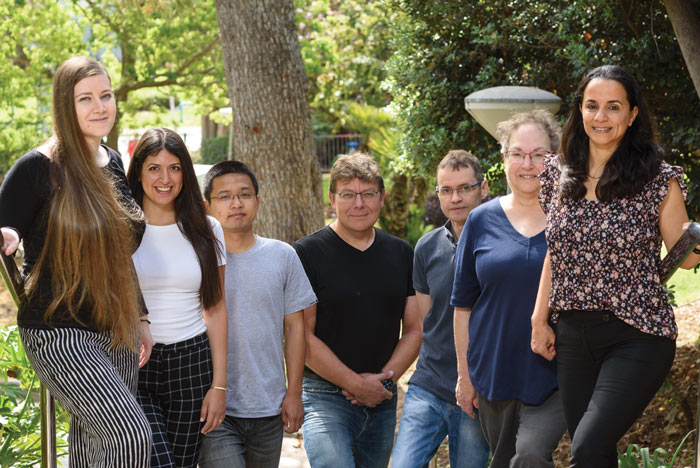Are you a journalist? Please sign up here for our press releases
Subscribe to our monthly newsletter:
From the creators of yo-yo crystals comes the brand-new sequel – hollow crystals. When a team of scientific investigators detected an enigmatic structure never before seen in a lab, they knew they could be on to something big. But first they had to solve the mystery of how these crystals materialized. This is a gripping story of “self-sacrifice,” “cannibalism” and contradictions, culminating in the formation of unique crystals that hold promise for uses in applications such as energy storage and carbon dioxide capture.
The hollow crystals, composed of six-connected half-rods that protrude circularly around an empty core, are so unique and contradictory to nature that for over three years now Prof. Milko van der Boom of the Weizmann Institute of Science’s Molecular Chemistry and Materials Science Department and his team have been trying to solve the mystery of how they came to be. “Our first reactions were: ‘Wow, what in the world have we created? How did they form? Are we able to reproduce the results?’” says van der Boom.
To follow the evolution of events leading up to the crystals’ formation, the scientists, spearheaded by Dr. Maria Chiara di Gregorio and Staff Scientist Dr. Michal Lahav, employed a series of techniques used in the 3D analysis of such crystals, including scanning electron microscopy (SEM) and the unconventional use of micro-computed tomography (micro-CT) measurements, usually used on human subjects for medical imaging purposes. This allowed them to capture images in intricate detail in order to corroborate their observations, as recently published in Nature Communications.

Commencing with a mixture of starting materials comprising organic molecules and metal salts – in this case, nickel bromide – they observed that these bind together to form a structure that initially serves as a “sacrificial” template and “feedstock” for the ensuing crystal. This quickly grew into a hexagonal-shaped structure, with its diameter tapering off at either end. Over time, the scientists witnessed striking scenes of “cannibalism,” in which the insides were “cored out” and “consumed,” propagating all the way through the structure. Another salient observation in conjunction with this event was the layering of additional materials onto its smooth outer surface. This combined “inside-out” mechanism gradually led to its transformation into the hollow, six-connected-half-rod crystal structure that the scientists initially happened upon. Despite this multidomain appearance, the scientists were also surprised to discover that these structures are uniformly ordered at the atomic level – in other words, single crystals – as evidenced by the patterns produced by X-ray diffraction techniques.
Van der Boom: "Our first reactions were: ‘Wow, what in the world have we created? How did they form? Are we able to reproduce the results?’"
Di Gregorio: “Crystals – whether naturally-occurring or synthesized in the lab – come in all different shapes and structures, which ultimately determine their properties and function. The hollow, single crystals we have created belong to a class of materials called metal-organic frameworks (MOFs), which are known for their porous properties. However, it is usually very challenging to control the synthesis and generate crystals with a geometrically uniform and defined micro-shape, let alone a curved morphology never seen before! This aspect may contribute toward increasing the arsenal of potential applications of these objects, for example, for catalysis, for the storage of environmentally-friendly fuels such as hydrogen or for capturing carbon dioxide from the atmosphere.”

Van der Boom and Lahav like to think that their research will have an even farther-reaching impact on a more fundamental level: “Creating these complex, paradoxical crystals in the lab and trying to solve their mystery, may help scientists advance toward figuring out the ultimate rules of nature.”
The scientists believe that these new findings confirm the idea that rather than oddities, these yo-yo and hollow crystals are among the first examples of a new class of single crystalline materials with sought-after properties. In fact, they have already added a third – egg-shaped crystals that have a brain-like texture – and plan to expand the repertoire even further.
Also participating in the research were PhD student Qiang Wen and MSc student Merna Elsousou of the Weizmann Institute of Science’s Molecular Chemistry and Materials Science Department, and Drs. Linda J. W. Shimon, Vlad Brumfeld and Lothar Houben of the Chemical Research Support Department.

The surface of 1 gram of hollow crystals can reach 7,140 square meters – the size of a soccer field
Prof. Milko van der Boom is the incumbent of the Bruce A. Pearlman Professorial Chair in Synthetic Organic Chemistry .
Prof. Van der Boom's research is supported by the Ben B. and Joyce E. Eisenberg Foundation; and Miel de Botton.